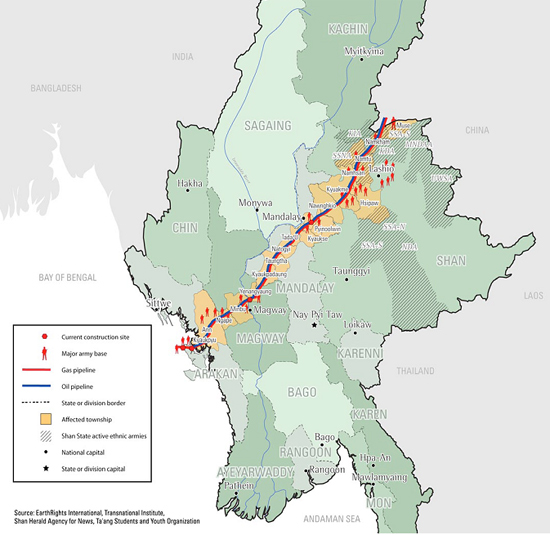China’s Pipelines in Myanmar
In order to meet energy demands in its resource-crunched eastern, southern and central parts, China is constructing oil and gas pipelines in Myanmar, almost reaching to the seashores of Bay of Bengal. Currently, the China National Petroleum Corporation (CNPC), in agreement with the Myanmar Oil and Gas Enterprise (MOGE) and the Myanmar state security forces, is engaged in laying a 982 km (620 miles) long crude oil pipeline from Kyaukpyu Port on the western coast of Arakan State linking Kunming after entering the border city of Ruili in Yunnan Province of China at a cost of US $2.5 billion. Concurrently, they are also constructing another gas pipeline, capable of delivering 12 bn cm of natural gas per year, from Shwe Gas off the Arakan coast up to Kunming. At the same time, a deep underwater crude oil unloading port and oil storage facility is being constructed at Maday Island (Arakan Coast) to serve as terminus for the tankers coming from West Asia and Africa.
The tri-project is expected to be completed by March 2013. However, China’s energy infrastructure outside its territory, particularly in Myanmar, is becoming increasingly vulnerable to sabotages and local opposition. The northern part of the Shan State in Myanmar, through which the pipelines are suppose to pass, are insurgency prone areas and yet to be secured by the Myanmar security forces.
Strategically, these pipelines will enable China to bypass the Strait of Malacca and cut the shipping distance by 1200 km. China is planning to bring in 20 million tonnes annually or 240,000 barrels per day of crude oil through Myanmar with tax concessions and customs clearance rights from the Myanmar government. Such developments would also be advantageous to China in terms of reaching out to the Indian Ocean. This may enable China in future to exercise greater influence in the South Asian region, much to the discomfiture of India; and, to counter the US naval presence in the Indian Ocean region.

As per media reports, there has been extensive acquisition of land by force besides violation of human rights and exploitation of locals at the pipeline construction sites. It has rendered the locals jobless, mainly the villagers of Kyaukpyu area, as their main livelihood was agriculture. It has angered the local masses, who have started protesting against the pipeline project. Generally, protestations by locals against initiation of such projects have been a common trend as it causes adjustment problems due to socio-economic changes in addition to displacement. The pipeline projects have become a sensitive issue in view of local resentment over the Chinese-sponsored dam projects in the recent past.
In September 2011, mass public protests had led to the revoking of the Myitsone mega-dam project on the Irrawaddy River at the confluence of the Mali River and the N’Mai River, about 42 km north of Myitkyina, capital of Kachin State, by President Thein Sein. It is understood that repetition of such incidents could be a setback for China’s growing energy interests in the country. As a mitigation measure, the CNPC is planning to give $6 million to Myanmar as aid and has already given $ 1.3 million to build schools in the project affected areas.
Myanmar is expected to earn US $1 billion annually as foreign exchange for three decades by the above project. However, the security of the pipeline remains doubtful. About half of the pipelines pass through insurgency prone areas of the northern Shan State, noted for frequent encounters between the armed ethnic groups and the Tatmadaw Army (Myanmar armed forces). Amongst the various insurgent groups active in northern Myanmar, the United Wa State Army (UWSA), the largest of all with approximate strength of 30,000 troops, and the Kachin Independence Army (KIA) with about 10,000 troops, have refused to accept the ceasefire offer of the Myanmar government including the offer to joint the Border Guard Force (BGF) under Tatmadaw command. The confrontation between the UWSA and the Tatmadaw has escalated in the recent past and the Chinese are very concerned since further deadlock between the two could harm the safety of the pipelines. For instance, the Konkan incident of August 2009 in the northern Shan State, when ethnic insurgent groups clashed with the Tatmadaw, had resulted in the destruction of heavy goods and infrastructure and cross-border migration of about 13,000 Myanmarese people in the Yunnan province of China. The Chinese linkages with the UWSA, especially its role in procurement of illegal arms for the insurgent group, are well known. As clashes between the armed militias and the Tatmadaw are likely to continue, the Chinese pipelines would remain vulnerable in times to come.
Furthermore, China is also engaged in constructing 810 km long railway line along the pipeline connecting Ruili in Southwestern Yunnan Province and Kyaukpyu Port along the Irrawaddy River, which is expected to be completed by 2013. Since its commencement from mid-2011, the railway line is half way through, crossing Mandalay towards the north. Building of railway tracks along the pipeline is justified by China as essential to transporting oil and petroleum to mainland China. The prospect of using the same for rapid mobilisation of troops in the name of securing its pipelines cannot be ruled out. It could also facilitate China in reaching out to the Indian Ocean.
The joint Sino-Myanmar military exercises conducted last year and increased cooperation, including frequent bilateral visits by military generals of the two countries, is also worth taking note of. As for India, it needs to keep a close watch on developments in Myanmar, especially pertaining China’s growing footprint in the country; and, accordingly enhance its preparedness to meet with any eventuality on its eastern front.




